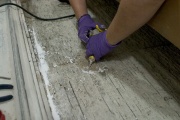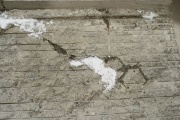Difference between revisions of "Paraloid B-72"
| (9 intermediate revisions by the same user not shown) | |||
| Line 4: | Line 4: | ||
[Rohm & Haas] A registered trademark for a clear, colorless, thermoplastic acrylic resin. Paraloid B-72 (formerly called Acryloid B-72 in the United States) is composed of an ethyl methacrylate (70%) and methyl acrylate (30%) copolymer. It was a shown to be a very stable resin for use in conservation (Feller 1972). Initially, Paraloid B-72 was supplied as white irregular lumps with a slight acrylic acid smell and a composition of ethyl methacrylate (68%) and methyl acrylate (28%); by 1976 the product changed to the odorless, transparent globules (de Witte et al 1978). Commercially, Paraloid B-72 is used as a general purpose coating. It produces a stable, wear resistant, nonyellowing finish. It is compatible with vinyl, cellulosic, and silicone resins. In conservation, Paraloid B-72 has been used as a coating, consolidant, and adhesive. Paraloid B-72 is supplied as solid pellets or as a 50% solids solution in toluene (Paraloid B-72 50%). | [Rohm & Haas] A registered trademark for a clear, colorless, thermoplastic acrylic resin. Paraloid B-72 (formerly called Acryloid B-72 in the United States) is composed of an ethyl methacrylate (70%) and methyl acrylate (30%) copolymer. It was a shown to be a very stable resin for use in conservation (Feller 1972). Initially, Paraloid B-72 was supplied as white irregular lumps with a slight acrylic acid smell and a composition of ethyl methacrylate (68%) and methyl acrylate (28%); by 1976 the product changed to the odorless, transparent globules (de Witte et al 1978). Commercially, Paraloid B-72 is used as a general purpose coating. It produces a stable, wear resistant, nonyellowing finish. It is compatible with vinyl, cellulosic, and silicone resins. In conservation, Paraloid B-72 has been used as a coating, consolidant, and adhesive. Paraloid B-72 is supplied as solid pellets or as a 50% solids solution in toluene (Paraloid B-72 50%). | ||
| − | [[File:DT 9-29-2004 08-B72 and microballoon fills.jpg|thumb|Paraloid B-72 and | + | [[File:DT 9-29-2004 08-B72 and microballoon fills.jpg|thumb|Paraloid B-72 and microballoon fills]] |
| − | |||
== Synonyms and Related Terms == | == Synonyms and Related Terms == | ||
| Line 13: | Line 12: | ||
[[[SliderGallery rightalign|Paraloid B-72 FTIR.PNG~FTIR]]] | [[[SliderGallery rightalign|Paraloid B-72 FTIR.PNG~FTIR]]] | ||
| − | == | + | == Applications == |
| + | |||
| + | == Personal Risks == | ||
| − | + | Talas: [http://talasonline.com/photos/msds/b72.pdf MSDS] | |
| + | == Collection Risks == | ||
| + | '''Links to Oddy Test results posted on AIC Wiki Materials Database Pages for individual materials below''' | ||
| − | + | [http://www.conservation-wiki.com/wiki/Oddy_Test_Results:_Exhibition_Adhesives_and_Tapes#Paraloid0001 Paraloid B72] tested in 2013 | |
| − | + | == Environmental Risks == | |
| − | |||
| − | |||
| − | |||
| − | |||
| − | |||
| − | |||
| − | |||
| − | |||
| − | |||
| − | |||
| − | |||
| − | |||
| − | == | + | == Physical and Chemical Properties == |
| − | + | * Soluble in toluene, xylene, acetone, carbon tetrachloride, MEK. | |
| + | * Paraloid B-72 made after 1976 is soluble in ethanol. | ||
| + | * Slightly soluble in isopropanol. | ||
| + | * Insoluble in aliphatic hydrocarbons, water, oils, grease. | ||
| + | * Molecular weight = 105,000 | ||
| + | * Tg = 40 C | ||
| + | * Refractive Index = 1.479-1.489 | ||
| − | == | + | == Working Properties == |
| − | + | == Forms and Sizes == | |
| − | + | == Resources and Citations == | |
| − | + | * Jerry Podany, Kathleen M. Garland, William R. Freeman, Joe Rogers, "Paraloid B-72 as a Structural Adhesive and as a Barrier Within Structural Adnesive Bonds: Evaluations of Strength and Reversibility" JAIC 40(1), 2001 ([http://aic.stanford.edu/jaic/articles/jaic40-01-002_appx.html link]). | |
| − | + | * J. Down, M.MacDonald, J.Te'treault, S.Williams, "Adhesive Testing at the Canadian Conservation Institute-An Evaluation of Selected Poly(Vinyl acetate) and Acrylic Adhesives", ''Studies in Conservation'' 41:19-44, 1996. | |
| − | ''' | + | * E. de Witte, M.Goessens-Landrie, E.J.Goethals, T.Simonds, "The Structure of 'Old' and 'New' Paraloid B72", ICOM preprints 78/16/3/1-9, Zagreb, 1978. |
| − | |||
| − | |||
| − | + | * R.L.Feller, N.Stolow, E.H.Jones, ''On Picture Varnishes and their Solvents'', the press of Case Western Reserve University, Cleveland, 1972. | |
* Ralph Mayer, ''A Dictionary of Art Terms and Techniques'', Harper and Row Publishers, New York, 1969 (also 1945 printing) | * Ralph Mayer, ''A Dictionary of Art Terms and Techniques'', Harper and Row Publishers, New York, 1969 (also 1945 printing) | ||
| Line 62: | Line 57: | ||
* Conservation Support Systems, Catalog, 1997 | * Conservation Support Systems, Catalog, 1997 | ||
| − | * Product Information | + | * Product Information: Rohm and Haas acryloid acrylic resins sheet.1986 |
| − | * | + | * CoOL DistList 2/10/2002 |
| − | * Website address | + | * Website address: www.rohmhaas.com |
| − | [[Category:Materials database]] [[Category:MWG]] | + | [[Category:Materials database]][[Category:MWG]][[Category:Coatings]][[Category: Coating: Solvent-based]][[Category:Adhesives]][[Category: Adhesive: Solvent-based]] |
Latest revision as of 15:37, 21 October 2022
Description
[Rohm & Haas] A registered trademark for a clear, colorless, thermoplastic acrylic resin. Paraloid B-72 (formerly called Acryloid B-72 in the United States) is composed of an ethyl methacrylate (70%) and methyl acrylate (30%) copolymer. It was a shown to be a very stable resin for use in conservation (Feller 1972). Initially, Paraloid B-72 was supplied as white irregular lumps with a slight acrylic acid smell and a composition of ethyl methacrylate (68%) and methyl acrylate (28%); by 1976 the product changed to the odorless, transparent globules (de Witte et al 1978). Commercially, Paraloid B-72 is used as a general purpose coating. It produces a stable, wear resistant, nonyellowing finish. It is compatible with vinyl, cellulosic, and silicone resins. In conservation, Paraloid B-72 has been used as a coating, consolidant, and adhesive. Paraloid B-72 is supplied as solid pellets or as a 50% solids solution in toluene (Paraloid B-72 50%).
Synonyms and Related Terms
Acryloid B-72; Paraloid B72; Paraloid B-72; Acryloid B-72 (sp); Acryloid B72 (sp); Paraloid B72 (Port.)
Applications
Personal Risks
Talas: MSDS
Collection Risks
Links to Oddy Test results posted on AIC Wiki Materials Database Pages for individual materials below
Paraloid B72 tested in 2013
Environmental Risks
Physical and Chemical Properties
- Soluble in toluene, xylene, acetone, carbon tetrachloride, MEK.
- Paraloid B-72 made after 1976 is soluble in ethanol.
- Slightly soluble in isopropanol.
- Insoluble in aliphatic hydrocarbons, water, oils, grease.
- Molecular weight = 105,000
- Tg = 40 C
- Refractive Index = 1.479-1.489
Working Properties
Forms and Sizes
Resources and Citations
- Jerry Podany, Kathleen M. Garland, William R. Freeman, Joe Rogers, "Paraloid B-72 as a Structural Adhesive and as a Barrier Within Structural Adnesive Bonds: Evaluations of Strength and Reversibility" JAIC 40(1), 2001 (link).
- J. Down, M.MacDonald, J.Te'treault, S.Williams, "Adhesive Testing at the Canadian Conservation Institute-An Evaluation of Selected Poly(Vinyl acetate) and Acrylic Adhesives", Studies in Conservation 41:19-44, 1996.
- E. de Witte, M.Goessens-Landrie, E.J.Goethals, T.Simonds, "The Structure of 'Old' and 'New' Paraloid B72", ICOM preprints 78/16/3/1-9, Zagreb, 1978.
- R.L.Feller, N.Stolow, E.H.Jones, On Picture Varnishes and their Solvents, the press of Case Western Reserve University, Cleveland, 1972.
- Ralph Mayer, A Dictionary of Art Terms and Techniques, Harper and Row Publishers, New York, 1969 (also 1945 printing)
- Paintings Specialty Group, Painting Conservation Catalog, Wendy Samet (ed.), AIC, Washington, DC, 1998
- Book and Paper Group, Paper Conservation Catalog, AIC, 1984, 1989
- Marie Svoboda, Conservation Survey Index, unpublished, 1997
- Conservation Support Systems, Catalog, 1997
- Product Information: Rohm and Haas acryloid acrylic resins sheet.1986
- CoOL DistList 2/10/2002
- Website address: www.rohmhaas.com


